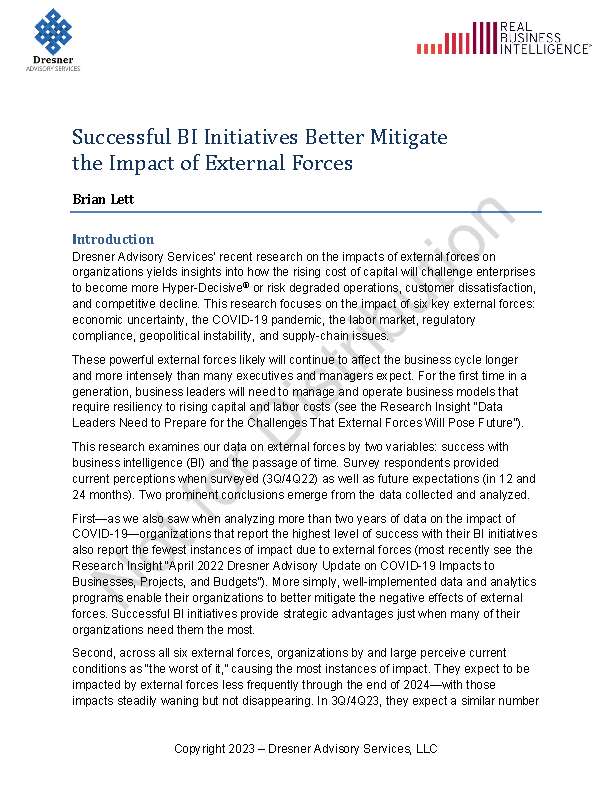
Six key external forces—economic uncertainty, the COVID-19 pandemic, the labor market, regulatory compliance, geopolitical instability, and supply-chain issues—likely will continue to affect the business cycle longer and more intensely than many executives and managers expect. For the first time in a generation, business leaders will need to manage and operate business models that require resiliency to rising capital and labor costs (see the Research Insight “Data Leaders Need to Prepare for the Challenges That External Forces Will Pose Future”).
This research examines our data on external forces by two variables: success with business intelligence (BI) and the passage of time. Survey respondents provided current perceptions when surveyed (3Q/4Q22) as well as future expectations (in 12 and 24 months). Two prominent conclusions emerge from the data collected and analyzed.
First—as we also saw when analyzing more than two years of data on the impact of COVID-19—organizations that report the highest level of success with their BI initiatives also report the fewest instances of impact due to external forces (most recently see the Research Insight “April 2022 Dresner Advisory Update on COVID-19 Impacts to Businesses, Projects, and Budgets”). More simply, well-implemented data and analytics programs enable their organizations to better mitigate the negative effects of external forces. Successful BI initiatives provide strategic advantages just when many of their organizations need them the most.
Second, across all six external forces, organizations by and large perceive current conditions as “the worst of it,” causing the most instances of impact. They expect to be impacted by external forces less frequently through the end of 2024—with those impacts steadily waning but not disappearing. In 3Q/4Q23, they expect a similar number of instances of impact to 3Q/4Q22 (less than 1 percent fewer, on average, across all six external forces). However, in 3Q/4Q24, 18 percent fewer organizations foresee impact due to the six external forces.
External forces provide data leaders with a clear call to improve data sources and quality and to invest in advanced analytics. But data leaders should not lead this C-level discussion with BI. Instead, they should start the conversation by showing how data and analytics approaches, competencies, literacies, processes, tools, management, and governance support specific near- and long-term business objectives while also enabling achievement of specific business outcomes.
After executives agree with this vision, data leaders should leverage the Dresner Advisory Services Hyper-Decisive® Maturity Model® to first benchmark the organization’s data and analytics competencies and capabilities, and then track the progress of their planned evolution (see the Research Insight “Introducing the Hyper-Decisive® Maturity Model”).
You do not have permission to access this document. Make sure you are logged in and/or please contact Danielle with further questions.